| The Growth of the
Town
As in the neighbouring towns, the population greatly
increased in the 19th century thanks to the availability
of employment in the new industries. This can be seen
from the census records:
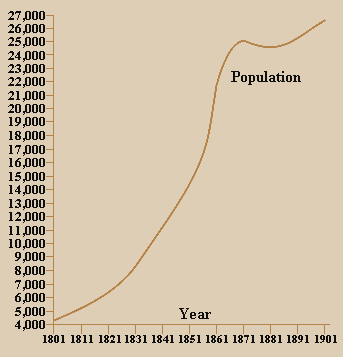 |
Although the population had greatly increased, the
town centre where most people lived, still occupied a
relatively small area around Trouse Lane, Upper and
Lower High Street and Bridge Street. Many of the houses
were tightly packed and others were at the back of
courtyards. |
The Market and Entertainment
The town became well known for its market, whose
roots go back to the 18th century. It all began in 1709
when Queen Anne granted a charter that
gave John Hoo the right to hold two annual fairs in the
town and a weekly market on Fridays. Fairs were
initially held on 25th April and 23rd July until the
calendar was altered in 1752, when the dates became 6th
May and 3rd August. The charter allowed the
sale of cattle, beasts, and all manner of goods,
including wares, and merchandise commonly bought in
fairs and markets.
At the time
John Hoo was lord of the manor, having purchased the
estate from the Shelton family. He was born around 1658
and became a member of the Bar and afterwards a
sergeant-at-law. He married Mary Hanbury of Whorestone,
Bewdley.
|
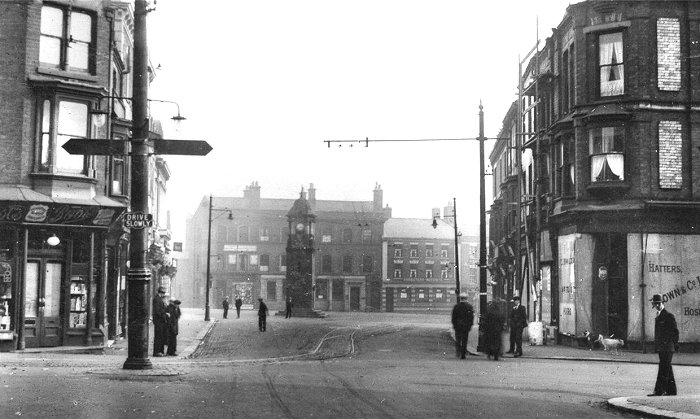
Looking into the Market Place.
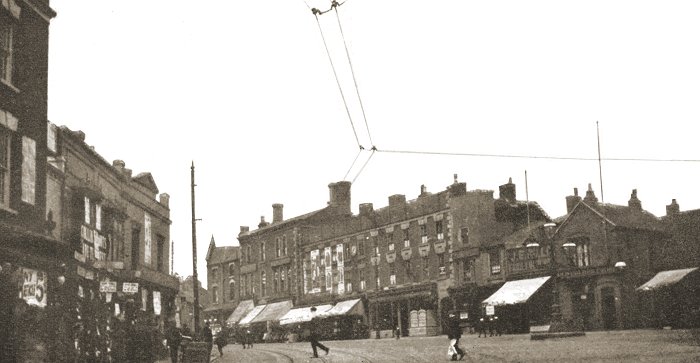
The Market Place in 1908.
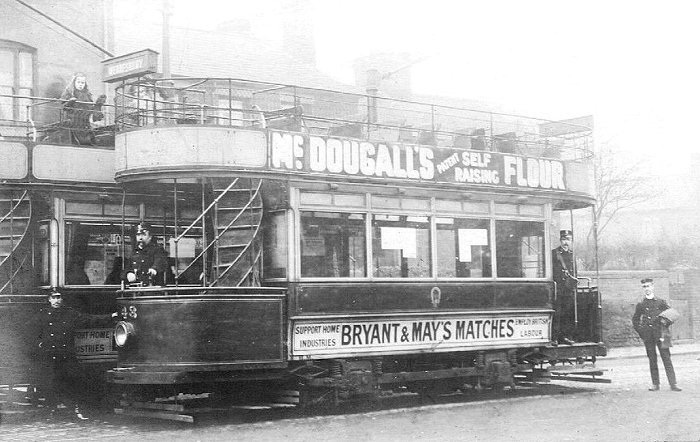
A tram on its way to Wednesbury. From an
old postcard.
| The market
cross building, possibly built in 1709, used to stand
approximately on the site of the present clock tower.
It
consisted of two rooms in an upper floor, resting on
pillars and arches. The rooms were reached by an
external flight of stairs on the northern side of the
building which were also used as a whipping post.
Offenders would be tied to the door posts and a public
flogging would be administered by the beadle.
The building
had many other uses. The Charity School, the Court of
Requests, and the Petty Sessions were all held there. By
1824 the building had been demolished after falling into
a bad state of repair.
By the early 19th
century Wednesbury
fair was in decline due to competition from
Walsall
and Wolverhampton.
By the 1850s the meat and cattle had gone and the fair
soon disappeared. The weekly market however, continued
to flourish in the Market Place until recent times. By
the early 19th century the Friday market had been
supplemented by the addition of a market on Saturdays.
In 1861 the market was purchased by the Local Board of
Health who fixed the trading hours as 5a.m. to 5p.m. on
Fridays and 12 noon until 11p.m. on Saturdays.
Today the Market Place is well
known for its fine clock tower which was designed by
local architect Mr. C. W. D. Joynson and built in 1911
to celebrate the coronation of King George V.
|
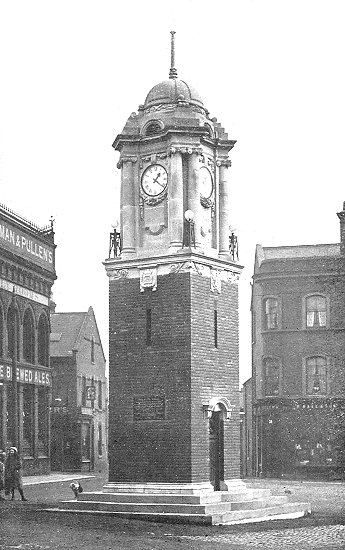 |
|
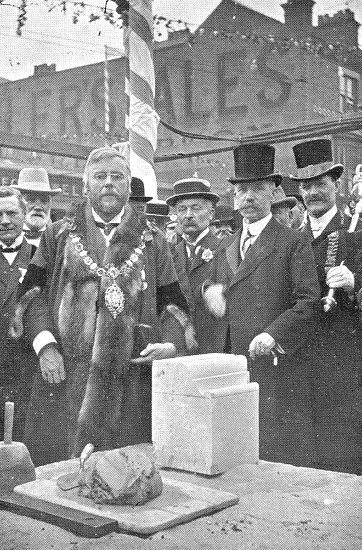 |
|
Wednesbury's Coronation Clock Tower. |
|
Laying
the clock tower's foundation stone on 22nd June,
1911. |
|
|
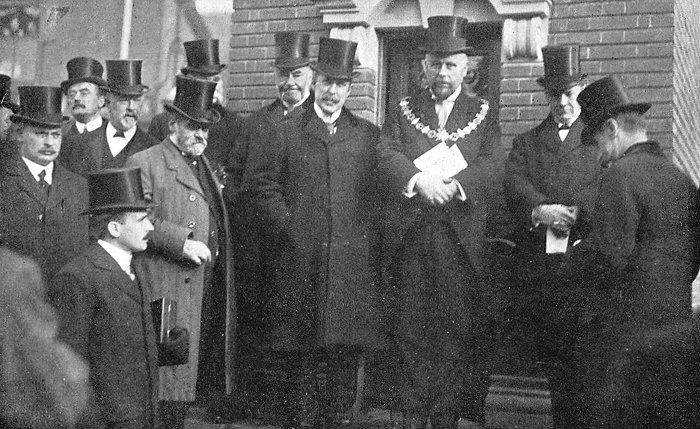
The dedication of the clock tower.
9th November, 1911. |
|
F. W. Hackwood
recalled in his “Wednesbury Ancient and Modern”, that he
was told of the sale of a wife, by an eyewitness, which
took place at a public auction held in the Market Place.
He also stated that this had happened on more than one
occasion.
The town also held an annual wake
on 23rd August, St. Bartholomew's Eve. When the modern
calendar was adopted in 1752 the wake moved to the first
week in September. Thousands of visitors flocked to the
town during wake week which became the local working
man's annual holiday. The wake extended from the High Bullen, through the Market Place to Bridge Street. |
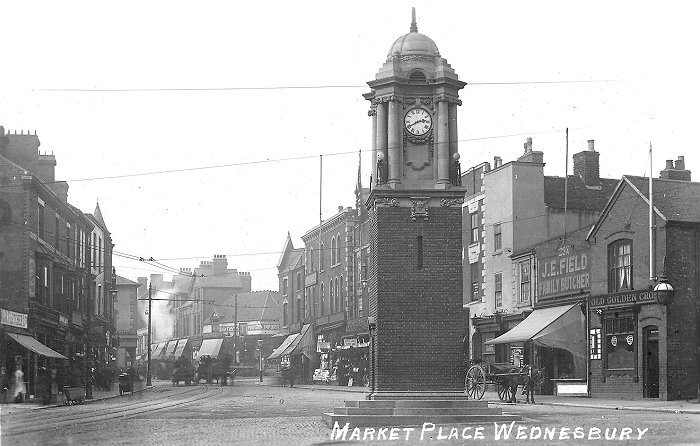
| It greatly annoyed the local
factory owners because their employees were away from
work that week and so there was no production. In 1874
Richard Williams, the Managing Director of the Patent
Shaft, the town's largest employer became Chairman of
the Wednesbury Local Board of Health. He was determined
to end the wake and with the backing of the local
Nonconformist church he convinced the Board to obtain a
Home Office Order to abolish the wake. From January 1874
the wake was not allowed to be held on the streets, but
the resourceful organisers moved the event to the Back
Field behind the Green Dragon in the Market Place.
Richard Williams became the most unpopular man in the
town, and the wake became a tradition that continued for
many years.
Bull baiting was held during the
wake, initially at the High Bullen, and later in Back
Field,
with as many as 6 bulls being bated each year.
Many of the participators wore long white aprons which
extended to the ground and were used to catch their dogs
after they had received a tossing from the bull. The
baited bulls would be killed and cut up on the Thursday
of wake week to provide cheap meat for some of the many
visitors who had by then spent most of their money.
Several of the town's public
houses could also be found in the Market Place. They
were the Talbot, the George & Dragon, the White Lion,
and the Green Dragon. In Bridge Street was the Red Lion,
the Coach and Horses (later known as the Coachmaker's
Arms), and the White Horse. In Vicarage Road is the
Leathern Bottle which claims to date from around 1510
and so is the town's oldest pub, which was rebuilt in
1913. In the 18th century the magistrates met there.
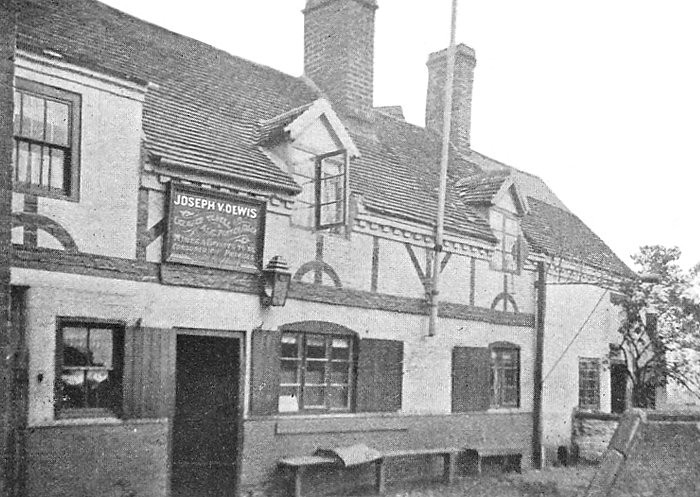
The Old Leathern Bottle.
Other pubs included the Duke of
York, and the Turk's Head, which is still to be found in
Lower High Street. Other survivors include the George in
Upper High Street, originally known as the King's Head
and the Blue Ball at Hall End, which is now listed and
known as Spittles. Several generations of the Spittle
family ran the pub and also sponsored local cockfights.
Cockfighting was
a popular pastime, and in the 19th century
there used to be a cock pit in Potters Lane. Birds were
reared and trained for the king, and annual “cockings”
were held at Wake time. They were attended by the
nobility and members of the sporting fraternity from all
over the country. Other sports included bear baiting,
and badger drawing. |
|
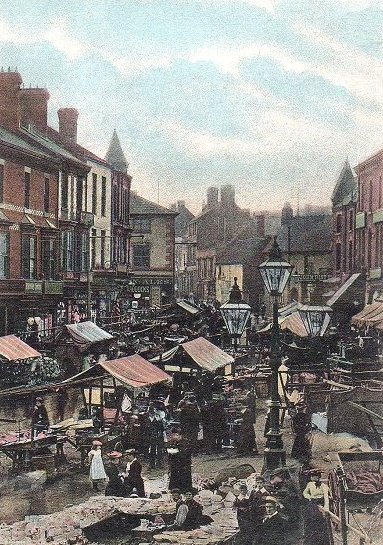
A busy day in the market. |
Horse race
meetings were held in Monway Field in 1778. They later
moved to a new course, and each meeting was followed by
a ball. Other activities included dog fighting, prize
fighting, flower shows and a visit to the Theatre Royal
in Earps Lane, which opened in 1859.
Wednesbury had a 9 hole golf club,
founded in 1908 in Hydes Road on land leased from the
Patent Shaft. In 1938 the company attempted to sell the
land to a private property developer, but the attempt
failed because of the onset of war. In 1947 the council
purchased the land and built the
Golf Links Estate, consisting of Woden Road South ,
Chestnut Road, Cherry Lane, Yew Tree Lane, Lilac Grove,
Walnut Lane, Cedar Road and Sycamore Road.
The Old Theatre Royal in Earps Lane
opened in 1859 and later became the Rialto Cinema. In
the 1960s it became the Midland Cinema Bingo Club but
soon closed, and was demolished in 1969. Another
theatre, the Hippodrome Theatre in Upper High Street
opened in 1891 as the New Theatre Royal. It survived
until April 1959 and was demolished in the early 1960s.
|
|
The Picture House opened in Walsall
Street on 25th March, 1915. In 1938 its name was changed
to the Gaumont and in 1964 it became the Odeon. It had
another name change in the early 1970s when it became
the Silver and is now Walkers Bingo.
Cholera
Cholera first
appeared locally at Bilston on 4th August, 1832 and
reached Wednesbury 5 days later. During the next two
months or so there were 285 cases in the town, and 95
deaths. The last case was reported on 12th
October. During the epidemic a temporary local board of
health was established, and the British School converted
into a hospital. 5 stations were set up for the
dispensing of medicine to the poor, and two medical
inspectors were engaged to provide daily reports on the
condition of people in the lodging houses.
A second
epidemic occurred in 1848 which resulted in 200 deaths
in the town. The Wednesbury Board of Surveyors erected
several huts on Monway Field for use as a temporary
hospital and a general undertaker was appointed for the
dead.
Each day the victim’s bodies were brought to the
church porch and buried in a communal grave. Many of the
cases occurred in St. James’ Parish, the poorest part of
the town. After the second
epidemic, the situation was taken in hand. In 1853 the
South Staffordshire Waterworks company was formed to
provide a clean and therefore safe water supply, to
prevent further outbreaks of the infectious disease.
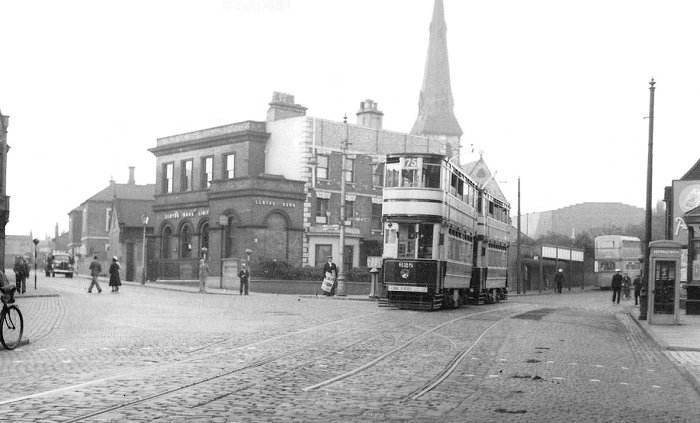
Bridge Street looking towards
Lower High Street.
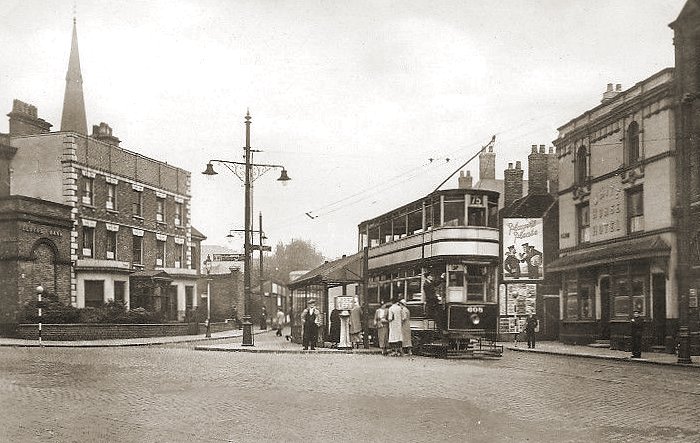
Another view of the bottom of
Lower High Street and the White Horse Hotel.
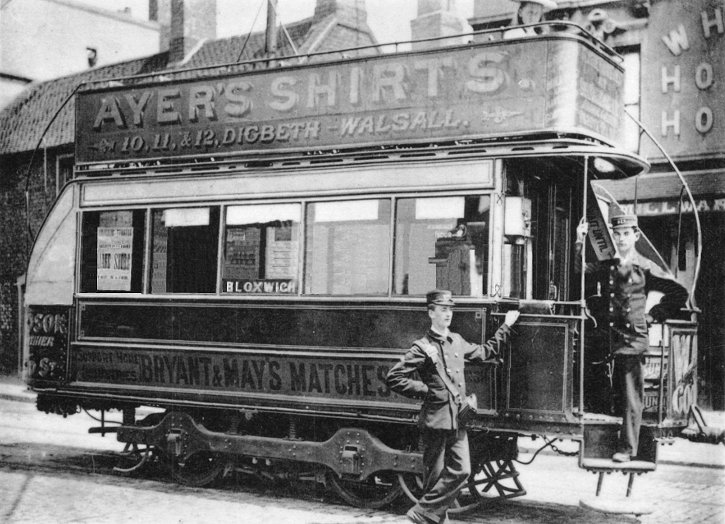
A tram outside the White Horse
Hotel. From an old postcard.

Another view of Lloyds Bank.

The toilets and horse trough at
the High Bullen.
In 1858 land was
acquired on Church Hill for the building of the
reservoir for the South Staffordshire Waterworks
Company. Work got underway in 1859 on the circular
reservoir which had an earth embankment, and could hold
1,538,190 gallons of water. It was 18 feet deep. By
November 1859, work on the reservoir itself had been
completed, allowing it to be part-filled. It came into
use in April 1861 when the project had been completed.
The work had been carried out by John Boys Limited.
In 1908 it was
recommended that the reservoir should be covered. It
remained open until 1923 when a roof, supported by 96
piers was built by Messrs. Davey & Company of Runcorn.
The reservoir continued in use until 14th May, 1974,
after which the site was sold.
Care of the Poor
By the turn of
the 17th century the parish was made
responsible for the well being of the poor thanks to the
Statute of Labourers in 1563, and the Poor Laws of 1598
and 1601. It became the annual duty of the parish to
choose an officer, usually around Easter, to administer
the Poor Law for the forthcoming year. The officer was
chosen at a vestry meeting and his name would be
submitted to a Justice of the Peace for approval. He
then had the power to raise taxes to supply funds for
relief of the poor. At the end of the year he had to
submit his accounts for the approval of the vestry. This
system lasted until the Poor Law Amendment Act of
1834 when a new system based on unions of parishes was
introduced. As a result Wednesbury parish became part of
the West Bromwich Union, run by a board of elected
guardians.
Wednesbury had its first almshouse
as early as the beginning of the 17th century
thanks to the bequest of Thomas Parkes, who died in
1802. He left £10 in his will for the care of the poor,
under the control of the vicar and churchwardens, who
were to pay £1 annually for ten years. He also gave a
house to accommodate a school for 10 poor children and a
cottage to be used as an almshouse for 2 persons.
Another bequest that provided money
for the poor was made in 1683 by Joseph Hopkins, an
ironmonger of Birmingham. He bequeathed £200 for the
purchase of land, in or near Wednesbury. Any money
earned from the land was to be given to help the poor.
The executor John Cotterell purchased 16 acres of land
in Darlaston and used its income to provide 3 coats and
3 gowns annually for 6 poor parishioners. The remainder
of the income provided bread and money for the other
poor inhabitants. The income greatly increased when coal
was found on the site. In 1823 it had risen to over £60
and provided 60 people with coats and gowns.
By the 18th century opinion had turned
away from almshouses, in favour of workhouses. The idea
was that the poor should earn their keep, and the threat
of the workhouse would act as a deterrent to anyone
seeking help, other than to those really in need.
|
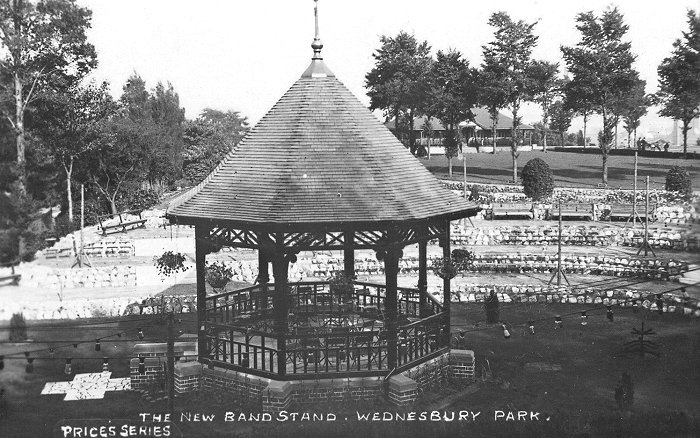
| By 1766 Wednesbury had acquired its first workhouse
consisting of four converted cottages in Meeting Street.
The cottages were purchased by John Addenbrooke and John
Cox in 1715, using the proceeds from a special rate
levied for the help of the poor. At least one of the cottages became an almshouse and
all four were converted into a workhouse within a few
years. By 1768 a small cell had been added for the
custody of any wrong offender in the parish, but in
practice it was rarely used. The governor’s favoured
method of punishment was to chain wrong doers to the
fire grates. |
|
In 1786 an inventory of the goods
in the workhouse included a list of the rooms, which
consisted of the following:
| The governor’s
kitchen, a cellar, a bedroom over the pantry
with 2 beds, a lower house and men’s ward, a
lower parlour, a men’s lodging room with 12
beds, a woman’s kitchen, a women’s lodging
room with 20 beds, a brewhouse and a bedroom
above, with 2 spare beds. |
Little regular
work was found for the inmates, although occasionally
they were hired out to local employers. The workhouse
continued in use until 1857, when it closed. As already
mentioned, Wednesbury became part of the West
Bromwich Union as the result of the
Poor Law Amendment Act of 1834. The union was declared
on 11th October, 1836 and included the following
parishes:
|
Handsworth with Soho and Perry Barr,
Wednesbury, West Bromwich, Oldbury, Warley
Salop, and Warley Wigorn. |
Pressure for
accommodation mounted and so the commissioners
eventually decided to build a new Union Workhouse in
Hallam Street, West Bromwich, which opened in 1858. The
old workhouse building at Wednesbury remained until 1920
when it was demolished.
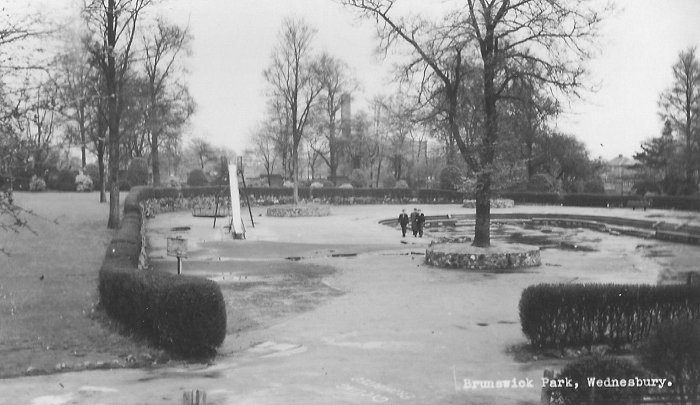
Health and
Sanitation
The 2nd Report of the Commissioners
on the Enquiry of the Health of Towns, published in 1845
states:
Wednesbury consists of one long
street, along the turnpike road, with many lateral ones
branching into courts and alleys, inhabited by the
working classes. There is no drainage worth the name, no
scavengers or system of cleansing, and the supply of
water very scarce and indifferent. There are no pipes
(though there is, it is said, a good supply near it, at
a high level above the town), a few pumps, and the wells
are often bad. The people complain much, and have to
carry water near a mile, or to buy at a halfpenny for
three cans.
The workhouse of the town has
very bad water in the well, and they are obliged to
fetch it for washing or drinking several times a day.
The courts, alleys, and small streets are unpaved or ill
paved, full of stagnant puddles, privies with open
vaults, pigsties, etc.; there is, in fact, no care taken
on these points, and the greatest neglect appears. I
find it stated "There is a dreadful stinking tank or
ditch at the back of the Turk's Head, where the
magistrates always meet, and the public enter by this
filthy place."
The damning report includes
footnotes on certain parts of the town:
|
Whitehouse Square |
Filthy choked-up privies,
and dirt holes overflowing. |
|
High Bullen |
Open drains, full and
stinking. |
|
Ledbury's Buildings |
Filthy open privies,
stagnant liquid filth and receptacles; bad
water generally; opposite court - bad
privies. |
|
Houses opposite Turk's
Head |
Open receptacle of liquid
filth. |
|
Miss Webley's Court |
Green stagnant puddles. |
|
Bullock's Fold |
Open terrible drains; no
water but by buying. |
|
Buck's Buildings |
Open privies, pigsties,
filth and ashes; open drain full of filth. |
|
Workhouse Fold |
Three had the fever in our
house, said a woman. One died; privy full,
filth overflows. |
Clearly something had to be done.
Of course the terrible findings didn't just apply to
Wednesbury, most towns and cities were much the same.
During the cholera epidemic which swept through England
from 1847 to 1849 the government established the General
Board of Health under the terms of the Public Health Act
of 1848. The new authority designated areas as local
health districts. If an area was not a borough it was
given the task of electing a local board of health to
oversee health and sanitation.
| |
|
| Read the story
of one of Wednesbury's most influential
families, The Lloyds |
 |
| |
|
The Wednesbury Local Board of
Health was formed on 26th December, 1851 and held its
first meeting on 14th February, 1852. The original
members were:
| Rev. Isaac
Clarkson - Chairman |
| Thomas walker |
| J. N. Bagnall |
| Edward Elwell jnr. |
| Benjamin Round |
| Joseph Smith |
| Jesse Whitehouse |
| James Frost |
| Samuel Lloyd, who
became chairman in 1853 |
The Board's powers to improve sanitation were wide
and included:
| Regulation of
sewers, drains, wells, and the disposal of
refuse. |
| Regulation of
highways, slaughterhouses, and lodging
houses. |
| Regulation to
ensure the provision of adequate supplies of
water and gas. |
| The provision of
burial and recreation grounds. |
The following officers were appointed by the Board:
|
Clerk - |
Francis Woodward |
|
Officer of Health - |
Dr. Palin |
Surveyor and Inspector
of Nuisances - |
John
W. Fereday |
|
Treasurer - |
Henry Williams |
|
Collector of Rates - |
John Griffiths |
Francis Woodward was a lawyer with an office opposite
the Turk's Head in Lower High Street. The Board's
meetings were held there until 1854 when they moved to
the Sessions Room adjoining the original police station
in Russell Street. The Board eventually built its own
offices in 1867 in Holyhead Road. Many of the
pavements consisted of pebbles and were very difficult
underfoot. Mr. John W. Fereday, the Town Surveyor
introduced blue bricks with a roughened diamond pattern
on the upper surface. Although they improved matters
they were often only laid across the half of the
pavement nearest the kerb. A rate of 1 shilling was
levied on the local population to pay for the Board's
activities. The Board's many achievements included:
| The building of
the Municipal Offices and Town Hall at a
cost of £4,500. |
| The building of
the public baths and free library at a cost
of £6,000. |
| The building of
the town's cemetery at a cost of £5,400. |
| A great
improvement to the town's streets at a cost
of £7,300. |
| The building of
deep sewers and the sewage works at a cost
of £5,000. |
| |
|
| |
|
|
View the Wednesbury entry in
Harrison, Harrod & Company's Directory and Gazetteer of
Staffordshire, published in 1861 |
 |
| |
|
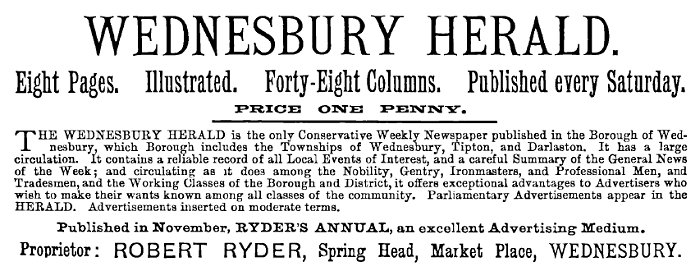
An advert from 1896.

From an old postcard.
|
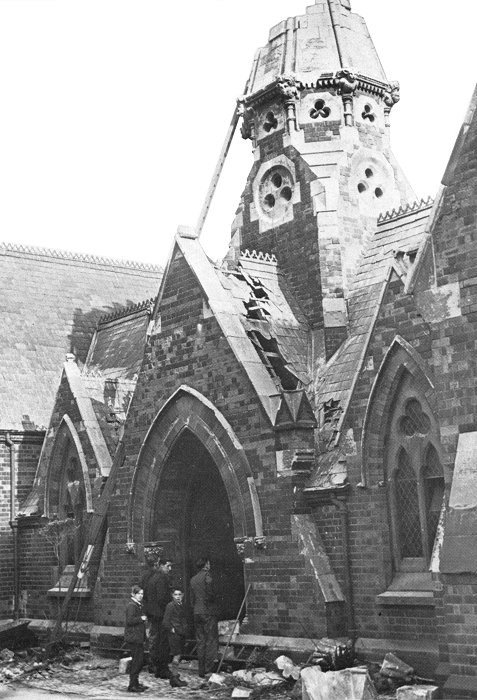
The mortuary chapel during
demolition. |
The cemetery opened in March 1868 on 12½
acres of land, and was extended in 1885.
It was built at
a cost of £10,000 and included the mortuary chapel shown
above, which was designed by Samuel Horton.
The
chapel was demolished many years ago and built in two
halves, one for Anglicans and one for
nonconformists, each holding around 80 people.
There was
also a cemetery keeper's lodge.
The cemetery was cleaned
up in June and July 2010 when many of the dilapidated
and neglected gravestones were removed. |
|
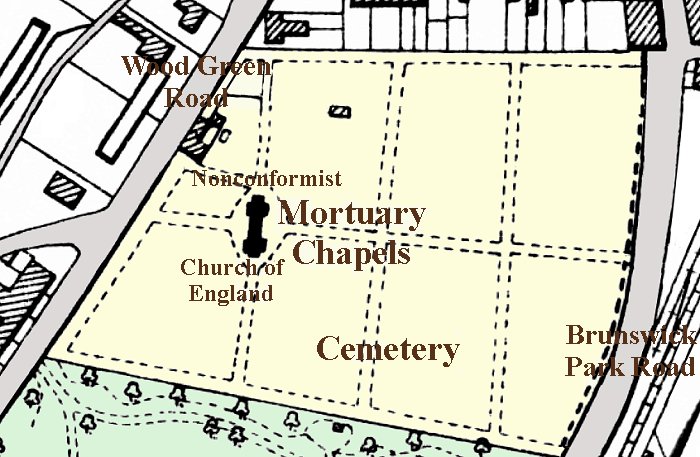
The cemetery and the mortuary
chapels. |
|
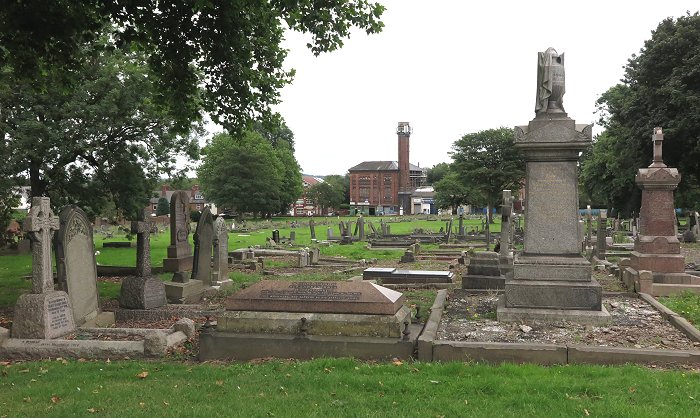
A view of the cemetery from
August 2021 with the old pumping station in the
background. |
|
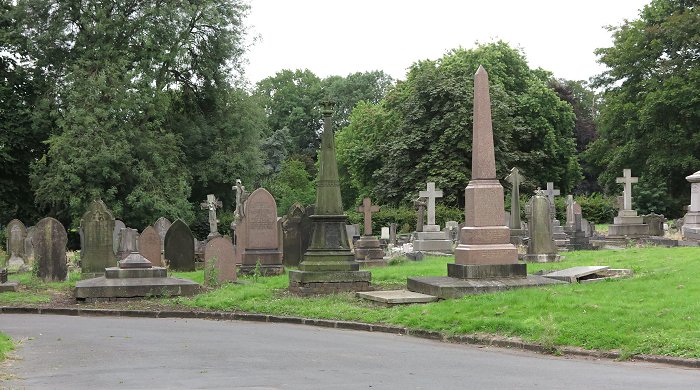
Another view from August
2021. |
|
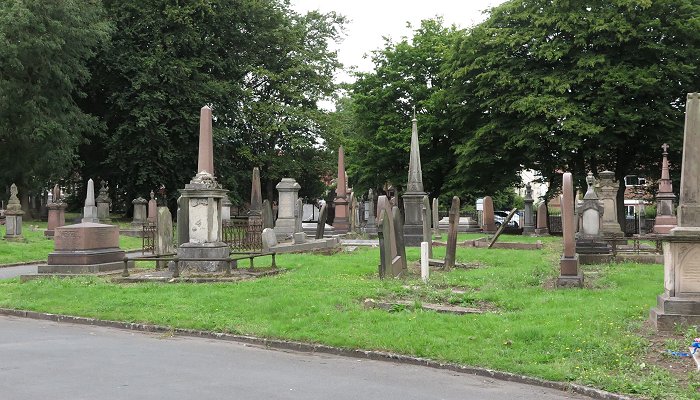
A final view from August 2021. |
| The Free Library
and Baths that stood on the corner of Walsall Street and
Brunswick Terrace, opened in 1878 and were built at a cost of
£6,700, £1,200 of which was given by public
subscription. They were officially opened by Richard
Williams, Chairman of the local Board of Health. The
library was demolished in 1912 and replaced with new
Education Offices. The baths closed in April 1973 and
were soon demolished. The sewage works were built on land at Bescot,
acquired in 1884. The works opened in 1888. |
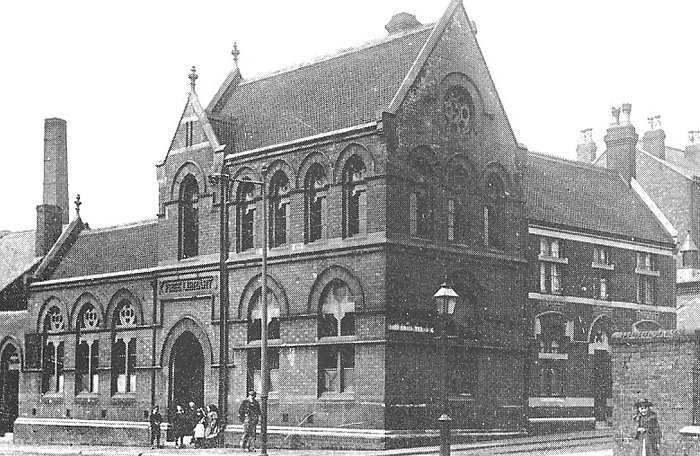 The old Free Library.
The old Free Library.
| The location of
Wednesbury's Free Library and Public Baths. |
 |
|
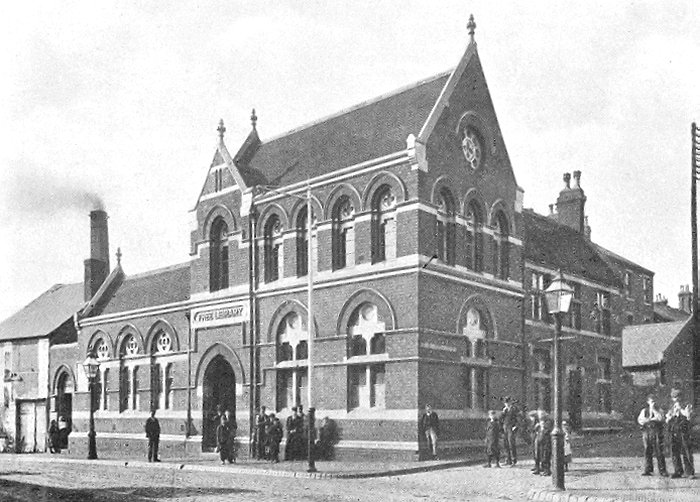
Another view of the old Free Library. |
|

The new library. |
| Other new amenities included Brunswick Park which
opened in 1887 and the Art Gallery which opened in 1891
as the result of a bequest by Mary Anne Richards, the
widow of coach axle manufacturer, Edwin Richards, who
died in 1880.
Edwin had acquired a collection of
paintings by contemporary artists and they were given to
the town along with £3,500 for the building of the art
gallery, and an endowment to pay for a caretaker. |
| |
|
|
|
|
Read about the
opening
of the
new library |
 |
|
Read about
Wood Green
Pumping Station |
 |
| |
|
|
|
|
| Although the Wednesbury Local Board of Health had
made great improvements in the town, it still came in
for criticism in a report made in 1875 by Dr. Ballard, a
Government Inspector. A number of slums have now
disappeared, among them being Oatmeal Square, Bolton
Square, Beggars Row, and Pitts Square. The properties
complained of were mostly courts and alleys contained in
an area stretching from Portway Road to the High Bullen
and Trouse Lane, all densely inhabited. In many other
parts pigsties were allowed too near the dwelling
houses. There was no compulsory notification of disease;
disinfection was attempted by the cheap and primitive
process of loaning whitewash brushes, and though the
general annual death rate was not particularly high,
infantile mortality was at times excessively heavy.
Fire Fighting The
town's first fire engine was donated by the Royal
Insurance Company on the understanding that it should be
free from financial liability, for any property insured
by them, on which the engine was called to protect. The
engine was kept in the yard at the Anchor Hotel on the
Holyhead Road. Unfortunately this was too far away from
the town centre to act quickly in an emergency. In 1899
the Borough Council built the town's first fire station
at the High Bullen. The local fire brigade however,
remained a voluntary organisation for many years. |
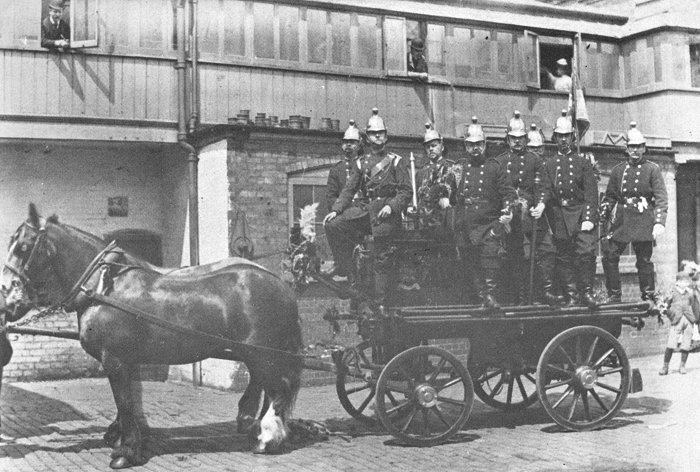
The volunteer fire brigade in the Anchor
Hotel yard in 1897.
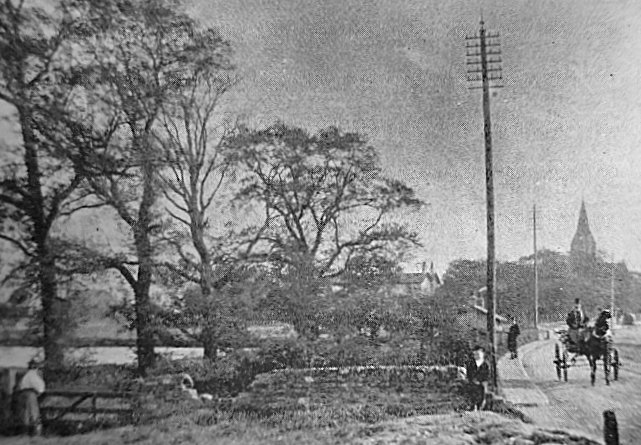
A view of old Wood Green looking
towards the residence of Mr. A. Elwell, J.P. which can
be seen behind the trees. St. Paul's Church is on the
right. |
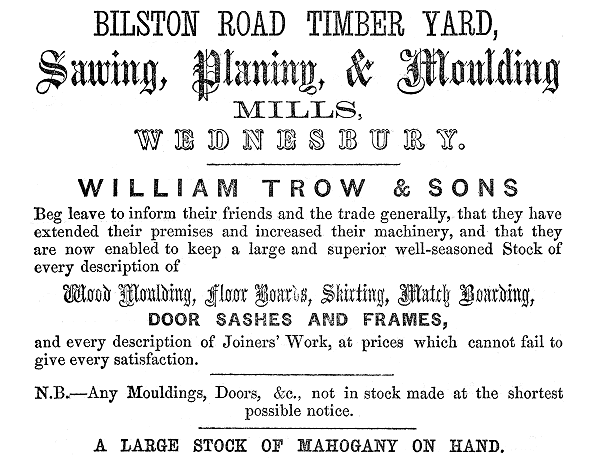
An advert from 1861.
 |
|
 |
|
 |
Return to
Transport |
|
Return to
the contents |
|
Proceed to Industries 2 |
|